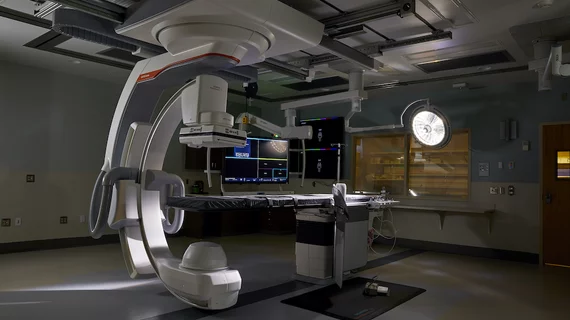Inside the next-gen hybrid cath lab
When the time came to select new angiography equipment at Benefis Health System in Montana, Michael Eisenhauer, MD, named three attributes the new suite would have to deliver without compromise.
Number 1 was image quality. Number 2 was image quality. Number 3? Say it one more time.
And yet, six months after the institution went live with its runaway pick, Eisenhauer, medical director of the institution’s cardiac cath lab, says his initial must-have checklist was too narrow.
That’s because he now believes the heart of the new lab—a ceiling-mounted ARTIS icono from Siemens Healthineers—is the best in its breed across numerous performance measures.
More on those in a bit. But first, cardiology departments around the U.S. mulling the purchase of a hybrid cardiac cath lab—one that readily accommodates interventional procedures, cardiac surgeries and diagnostics alike—may find it helpful to consider the experiences of peers at Benefis.
Due diligence done
Benefis Health is a two-campus, 530-bed system serving around a quarter-million people. Its geographic catchment area spans nearly one-third of the Big Sky State. It has a 33-room emergency department and hosts a two-aircraft medivac operation.
Each year the system’s interventional cardiology department performs approximately 1,000 diagnostic heart caths, 400 coronary interventions and 150 electrophysiology studies. In addition, the team annually implants around 175 pacemakers and defibrillators.
The department realized it needed a new cath lab when several factors came together. One was a marked increase in demand for peripheral vascular procedures. Another was a similarly sizeable rise in structural heart disease: In this first year, the department has completed close to 30 transcatheter aortic valve replacements (TAVRs).
The new cath lab was to be the fourth of four interventional suites marked for upgrades in 2021. Two of these were for interventional radiology and two for cardiology, including one hybrid suite and one standard. By the time the hybrid cath lab’s number came up, Siemens Healthineers had already won over the outfitters of the other three upgraded suites.
But that didn’t mean Siemens Healthineers and ARTIS icono were a shoe-in. “We did due diligence,” Eisenhauer says. “Including Siemens, we looked at five angiography systems. Ultimately we chose Siemens because, frankly, we thought they were going to be the best for us.”

The ceiling mount “provides a lot of flexibility for positioning the gantry, the patient and all the team members. You can have any combination of anesthesiologist, surgeon, cardiologist, technologist and nurse, and everyone has room to move around as they need to."
- Michael Eisenhauer, MD, Medical Director, Cardiac Cath Lab, Benefis Montana
Bonus points came when the FDA cleared the ARTIS icono Ceiling model just a few months prior to decision time, in July 2022. For Benefis, this would mean state-of-the-art technology with a long shelf life.
The ceiling mount “provides a lot of flexibility for positioning the gantry, the patient and all the team members,” Eisenhauer notes. “You can have any combination of anesthesiologist, surgeon, cardiologist, technologist and nurse, and everyone has room to move around as they need to.”
In addition, the team pre-installed a lateral-movement platform for the gantry. They are now awaiting FDA approval before activating this new feature.
Early stress test
The hybrid cath lab started serving patients this past April, marking the first American installation of a ceiling-mounted ARTIS icono.
Eisenhauer says that first week is etched in his mind. At one point, he treated two patients consecutively. One was a 105-pound woman, the other a 450-pound man.
“I was pleasantly surprised,” he says. “I could barely tell any difference in image quality between those two. I could see everything I needed to see in both cases. And the system itself didn’t even hiccup.”

“Before we had the icono, we wouldn’t have been able to do [a 500-plus pound patient] case safely—and may not have been able to do the case at all. In this case I just went in, popped one table extension off, popped the other table on and we were able to catheterize this patient who needed [cardiovascular intervention].”
- Windy Hurst, RT, Supervisor of the Cardiac Cath Lab
Cath Lab Supervisor Windy Hurst, RT, remembers a separate case with a bariatric patient weighing more than 500 pounds. She was not only able to ease the patient onto the ARTIS icono table without assistance but also to feel confident using the shorter and more weight-supportive of the system’s two tables.
“Before we had the icono, we wouldn’t have been able to do the case safely—and may not have been able to do the case at all,” Hurst says. “In this case I just went in, popped one table extension off, popped the other table on and we were able to catheterize this patient who needed [cardiovascular intervention].”
Eisenhauer adds that the patient may have had a different outcome if not for the ARTIS icono Ceiling system.
“With our older angiography machines, it may not have been worth doing the catheterization,” he says. “You wouldn’t have been able to see crucial areas of interest. With this machine, regardless of patient-level challenges, the images are always good enough for diagnostics and, when needed, good enough to guide intervention.”
Close and closer
For Jeffrey Harris, MBA, manager of the Benefis Heart and Vascular Institute, Siemens Healthineers has validated the soundness of the selection with their service and support. In a word, that would be their people.
Harris recalls a period during the runup to the go-live when Benefis suffered some unforeseen staff departures. Suddenly the system was down one facilities director and two key managers. “Without onsite support from our Siemens experts, we may have faltered,” he says. “They were instrumental from the initial phase of purchase to the service and support agreement to multiple site visits for equipment setup and staff training, which they’re still involved with.”
In fact, Siemens Healthineers dispatched product and applications experts to Great Falls for March and into April.
“After the lab was installed, we literally handed them the room for three whole days,” says Harris, who served 20 years with the U.S. Air Force prior to joining the private sector. “We used our other cath lab for procedures and stayed out of their way for a few days. The partnership blossomed at that time, but it’s really been a very close partnership from Day 1.”
In their own words
As for other key performance measures making their mark, the Benefis Health team shares their own experiences:
- Radiation reduction. Cardiologist Michael Eisenhauer, MD: “We’re seeing at least 50% reductions in radiation exposure vs. our previous system. I did a pacemaker implant the other day with a radiation dose of just 0.015 Gy. I couldn’t believe how low it was. I got the pacemaker in with no problem. And I’ve done diagnostic heart caths with far less than 0.1 Gy. The ARTIS icono Ceiling exposes people—and I mean healthcare workers as well as patients—to far less ionizing radiation than our prior systems.”
- Total control. Cath lab supervisor Windy Hurst, RT: “You can make changes to your big display monitor layout at the touch of a finger. Plus you can add profiles for different physicians’ preferences, like making the C-arm go to a certain location or doing an overlay. All those things that you would do a lot during a case, you can put them on the favorites menu. Little things like that have been instrumental in improving our efficiency.”
- Memory features. Eisenhauer: “I can not only save an image at a certain angle but also return to that angle later in the intervention with just one touch. Plus it has useful [digital] shortcuts along with some manual [analog] keys where I can reach over, tap something and quickly do what I need to do.”
- Thorough training. Hurst: “Probably the biggest challenge for the technologists is remembering all the things the ARTIS icono can do. That challenge is lessened by the system being highly intuitive and by Siemens’s people training us in phases—from the basics prior to go-live to more complex actions any time after.
- Handy hybrid. Heart and vascular manager Jeffrey Harris: Endovascular aneurysm repair, or EVAR, has historically been done in the OR with our vascular surgeons. They have now moved those cases to the hybrid room on the strength of its image quality and flexibility. The surgeons like this room that much.”
Offering additional comments in writing, the team notes: “Next-generation platform” … “More intuitive user interfaces” … “Customizable on the fly” … “Superb technical support and training” … “Much less radiation exposure to patients and staff” …
Momentum builds
Suggesting actions speak louder than words, Eisenhauer points out the four-suite project launched in 2021 has since expanded beyond the initial two cath labs and two interventional radiology suites. For example, Benefis has replaced portable C-arms in the operating room with Siemens Healthineers products in that category, and the institution is opening a cardiac MRI service line with a Siemens Healthineers scanner.
In addition, the cardiology team is now doing hybrid cases in the ARTIS icono Ceiling cath lab in which, as Eisenhauer puts it, “they’re literally doing an open surgical endarterectomy in one leg and then hopping over and doing a balloon and a stent in the other leg—both at the same time.”
Meanwhile, in late summer Benefis started using the hybrid room for transcarotid artery revascularization, or TCAR, a minimally invasive means of performing hybrid surgical and carotid artery stenting.
“So we are getting real hybrid cases done in this hybrid lab, and the lab is allowing us to offer procedures that we haven’t been able to provide our patients before,” Eisenhauer concludes. “The ARTIS icono Ceiling hybrid cath lab is giving us the confidence and momentum we need to do all of that and possibly more.”
Learn more about ARTIS icono angiography systems from Siemens Healthineers here.

